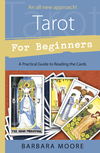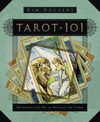Tarot: Fooling Fortune

Although tarot readers emphasize the positive aspects of the cards in a reading, there is no getting around the fact that the appearance of certain cards is alarming because of their potential predictions of bad things to come. Here, let me interject that, as someone who has written four books on tarot, I am certainly interested in prediction; however, I do not believe in such a thing as inexorable Fate—just in the tendency of our attitudes and habits to take us down certain roads, and our actions to invite certain reactions. Although karmic factors come into play, some bad karma can be mitigated or outrun. I also allow for genuine randomness and fortuitous turns of events.
With these principles in mind, we may note that finding ways to improve one's luck and change one's path of destiny has always been a concern of folk magic, so many magical principles can be used to turn things around when you get a disturbing tarot reading—likewise if you have been experiencing a sense of foreboding or a run of bad luck. Here, imagery from the Fool, the Hanged Man, and the Death cards can suggest folk magic techniques for disrupting fixed energy, thought, and behavior patterns and getting out of the negative feedback loops that make for bad luck.
Sometimes the Fool denotes an innocent bungler, but in folklore, fools can also be tricksters. The Trickster archetype can be both cleaver and foolish, or cleverly foolish, or foolishly clever, and in so behaving, he sometimes baffles the decrees of fate.
In many magical traditions, a person experiencing troubling thoughts or negative energies can deflect them by playing the Fool.
Fool-type absurdities can include tricking supernatural forces by behaving like an animal, using nonsense words, dressing outlandishly, wearing masks or costumes—even cross-dressing—or taking on a nickname (often something ridiculous, so evil spirits won't bother you). Along with these are many "reversal" actions such as talking backward, putting one's clothes on backward or inside-out, or standing on one's head or turning somersaults. Disruptive behaviors such as noisy pranks, acrobatics, water squirting, and telling obscene jokes are also part of the Fool's repertoire, as are childish behaviors such as playing with toys, skipping or swinging, and other youthful amusements. Some of these antics can be performed turning your shirt inside-out), while others might be acted out during a period of ritual clowning. Reversal holidays like Halloween and Carnival can allow entire populations to rejuvenate themselves in this manner.
Indeed, anything that provokes laughter is part of the Fool's repertoire, and laughter is magically protective for a great number of reasons, including the fact that when we laugh, we show our teeth
The Hanged Man's Perspective
Some of the reversal actions associated with the Fool can also apply to the Hanged Man, for, by breaking up one's trend of thought, they promote new ways of seeing (which is one interpretation of this card). Many societies use the act of ritual reversal to overturn ordinary reality, gain insight, reverse time, and establish sacred space. For example, Congo magicians perform cartwheels and walk on their hands as a way of walking in the otherworld. Reversals can also provide a glimpse of the mythical world, as in the case of sum Inuit groups who hold that people walked on their hands in the Original Time, before Raven turned the world upside down (establishing our present condition).
Another way to emulate the Hanged Man is to take a "time out." To the extent that you are able to suspend some of your activities, plans, and obligations to other people. It would be good if you could experience a period of doing nothing but carrying out the most basic requirements of work and life. If you can get away on vacation, go to a place that is very different from what you would normally choose. That is something that creative people do to provoke new insights and that shamans prescribe to effect healing; it also ties in with the spiritual practice of pilgrimage. However, don't have any expectations that anything special will happen. If nothing does happen to give you new perspectives that is okay. You can return to your daily routine, trusting that changes are at work on an unconscious level.
Another meaning of the Hanged Man is sacrifice. People seeking to change their luck have traditionally entreated the gods or spirits with votive offerings, which are tokens given as a pledge to fulfill a vow in exchange for spiritual aid, or as thank-offerings for wishes granted. (In keeping with Hanged Man symbolism, votives can take the form of objects suspended from trees; in Greco-Roman society, these were often in the form of masks, puppets, and different types of pendants.) Another type of sacrifice is the give-away, which is a practice of the Plains Indians and others, where people hold or attend a gathering where they give away a large number of personal goods. In the most extreme cases (such as great misfortune or life-threatening illnesses), a person might give away everything that he or she owns. This was a custom among some Jewish and Inuit groups, such as the Padlimiut band of Caribou Inuit, who held that "whoever would invoke the Great Spirit must have no possessions save his breath." However, that is just one spiritual viewpoint. If you decide to make some sacrifice, you have to consider what level of sacrifice would be appropriate to your own situation.
Death and Transformation Rituals
The things that the Death card represents are intrinsic to many processes of transformation. This idea is represented in older versions, which showed not just a dry skeleton, but decomposition, as well as growth in the form of sprouts emerging from the earth.
Many traditional societies have rituals that help ailing or unlucky individuals renew themselves by taking them through a symbolic death and transformation. The ritual death phase may involve giving away all of one's belongings (as mentioned above), or being symbolically dismembered by dancers with monster masks, or by lying in a grave or coffin or wrapped in a shroud while funeral rites are read. The renewal phase may involve burning one's old clothes and donning new ones, or taking on a new name, or crawling through an arch of boughs or between the legs of a woman or re-entering the house through a hole opened in the roof, or even by being given a new set of parents. The purpose of these actions is expressed in a Jewish renaming ritual from the 1600s: "If death has been decreed for [name], let it not be fulfilled. Now he is a different person, like a new human being, a child just born."
In ordinary everyday tarot readings, the Death card is likely to point to endings and beginnings in more mundane affairs, so it might be a bit of overkill to put on an elaborate ritual or make other drastic changes in response to it. However, you can symbolically take yourself through the transformation process.
After considering whatever advice your reading has offered, lay out the Death card, followed by your significator card, the Judgment card, and the World card. Then say, "I [name], son/daughter of [name parents], acknowledge that I have made a break with the past. Now am I renewed into a life of happiness and wholeness." If you would like to go to extra effort, you could reinforce the symbolism by first putting your significator into a little box and burying it in the ground, then resurrecting it for the tarot rite.
At this point, we can see how many other tarot cards and readings can prompt theatric ritual gestures for changing one's luck. For example, the World could suggest a new spin on the old Scandinavian custom of dancing out the trolls. The Tower could suggest the Voodoo practice of overturning a cup, or the old Indian and Babylonian custom of breaking posts to disperse bad influences. Interestingly, the physical motions and sensations of breaking crockery are said to be very therapeutic. Cups, bowls, and plates might also be overturned or broken as a way of releasing issues and anxieties associated with different Cups and Pentacles cards, while for Swords and Wands issues you might practice some knife-throwing or arrow-shooting, which are also traditional protective practices (assuming you have a nice outdoor space where you won't endanger anyone). Even people who don't believe in magic may be able to appreciate how these dramatic actions can give a person a sense of relief and a refreshed outlook.
Excerpted from Llewellyn's 2008 Tarot Reader, by Janina Renée. For more tarot books and decks, click here.
About Janina Renée
Related Products


is subject to certain Terms and Conditions